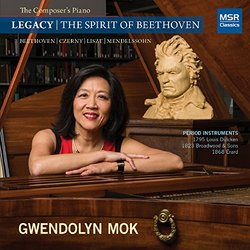| All Artists: Gwendolyn Mok (pianoforte) Title: The Composer's Piano: Legacy - The Spirit of Beethoven (Works by Beethoven, Czerny, Liszt and Mendelssohn performed on Period Instruments) Members Wishing: 0 Total Copies: 0 Label: MSR Classics Release Date: 12/3/2015 Genre: New Age Style: Instrumental Number of Discs: 1 SwapaCD Credits: 1 UPC: 681585159026 |
Search - Gwendolyn Mok (pianoforte) :: The Composer's Piano: Legacy - The Spirit of Beethoven (Works by Beethoven, Czerny, Liszt and Mendelssohn performed on Period Instruments)
 | Gwendolyn Mok (pianoforte) The Composer's Piano: Legacy - The Spirit of Beethoven (Works by Beethoven, Czerny, Liszt and Mendelssohn performed on Period Instruments) Genre: New Age
Ludwig van Beethoven's profound impact on the musicians who followed him is difficult to exaggerate. He has influenced countless composers and performers as well as poets, artists, writers, and philosophers from his own ti... more » |
Larger Image |
CD Details
Synopsis
Product Description
Ludwig van Beethoven's profound impact on the musicians who followed him is difficult to exaggerate. He has influenced countless composers and performers as well as poets, artists, writers, and philosophers from his own time to the present, in ever expanding circles that spread throughout Europe to eventually encompass the globe. Perhaps none felt Beethoven's influence more, however, than those musicians who were in the center of those circles, particularly his own students and their musical progeny. These recordings by Gwendolyn Mok explore Beethoven s influence as a pianist and composer for the pianoforte on three later 19th century composer-pianists who were connected to him in varying degrees: Carl Czerny, Franz Liszt and Felix Mendelssohn. The recordings also demonstrate some of the developments in the pianoforte from the 1790s to the 1860s. Mok selected different historical keyboards to reveal the broad array of timbres available to pianists of the nineteenth century. Beethoven may have begun his musical studies being groomed as a performer at the pianoforte by his father, who organized the boy's first public concert at the age of seven. When he moved to Vienna in 1792 to pursue his passion for composing music, his phenomenal skill on the pianoforte helped him gain entry to the palaces and patronage of the Viennese aristocracy. His early works such as the three Kuerfursten Sonatas composed in 1783, before his thirteenth birthday, and the sets of variations for pianoforte composed between 1782 and 1803 reveal his precocious command of the pianoforte of the 1780s. About the Instruments - The pianofortes used in this recording are from the historical keyboard collection at The Ira F. Brilliant Center for Beethoven Studies and the School of Music and Dance at San Jose State University. Three instruments at the Beethoven Center represent pianofortes from Beethoven s time, including a reproduction of a 1795 Viennese pianoforte by Jean-Louis Dulcken built by Janine Johnson and Paul Poletti in 1985 (gift of Irma and Ira Brilliant), an original 1823 English pianoforte by Broadwood & Sons (gift of the American Beethoven Society), and an original Viennese pianoforte built by Mathais Jakesch in 1827 (gift of James F. Green, Irma and Ira Brilliant, and other members of the Society). The collection in the School of Music and Dance has pianofortes dating primarily post-1860, including an 1861 English Érard, an 1868 French Erard, a 1871 Viennese Streicher and an 1878 Broadwood. These instruments are available to students for practice, performance and research on historical performance practices. Born in New York City, Gwendolyn Mok has appeared in many of the world's leading concert halls, including the Barbican, Carnegie Hall, the Kennedy Center, Avery Fisher Hall, Alice Tully Hall, Davies Symphony Hall, and the Hong Kong Performing Arts Center. Mok is frequently invited to play and record with major international orchestras, including the London Symphony Orchestra, Philharmonia Orchestra, Hong Kong Philharmonic Orchestra, Beijing Philharmonic Orchestra and Residency Orchestra of the Hague. Renowned Ravel expert Vlado Perlemuter, who in 1927 sat with Ravel at the keyboard of his Erard grand piano and worked his way through the composer s entire oeuvre, chose Mok to be the last student to whom he would pass on this special direct knowledge. Since 1995, she has been performing Ravel s works in recital, as well as teaching them at the Royal College of Music, Welsh College of Music and Drama, Dartington International Summer School, Shanghai Conservatory of Music, San Francisco Conservatory of Music, and elsewhere.

 Track Listings (30) - Disc #1
Track Listings (30) - Disc #1